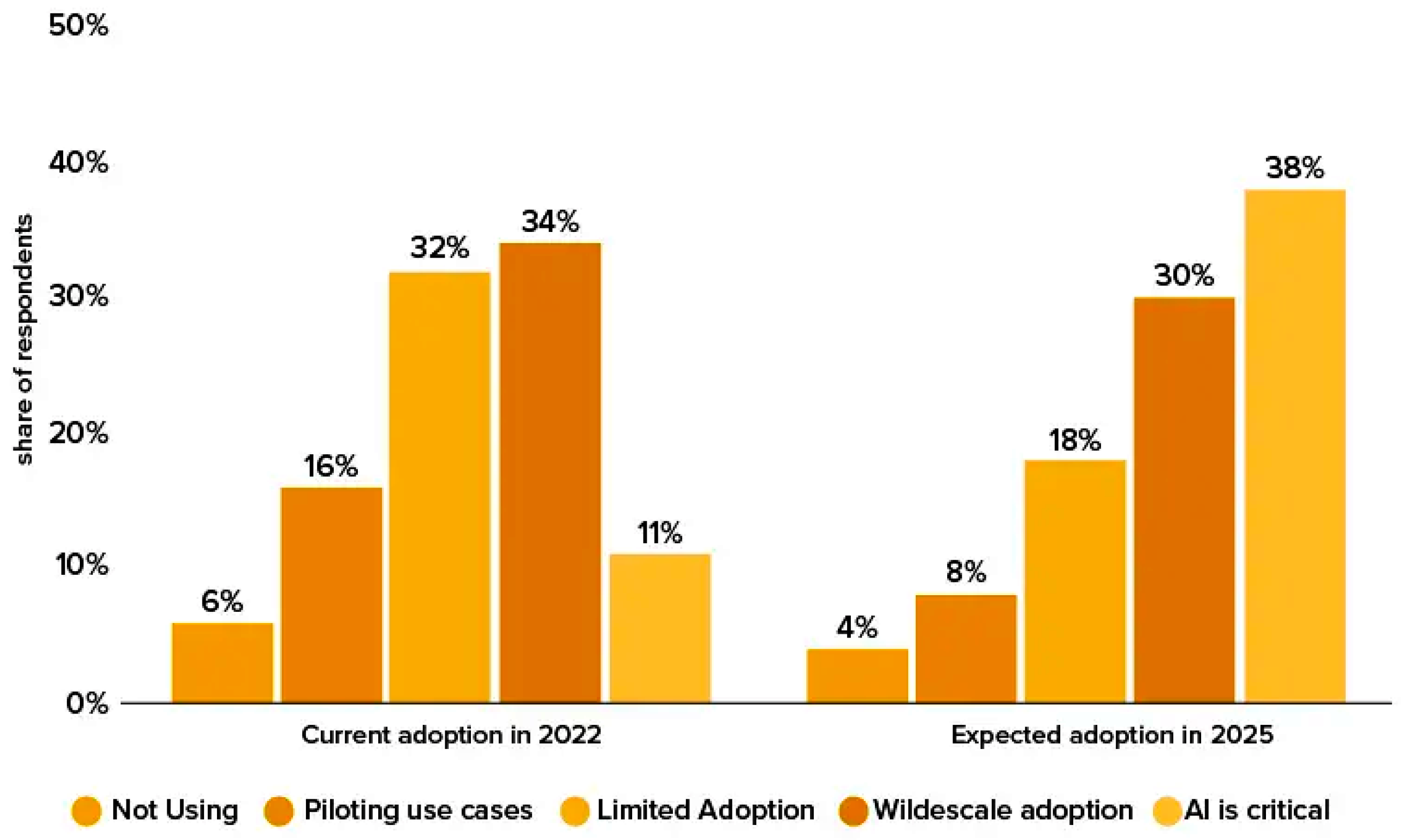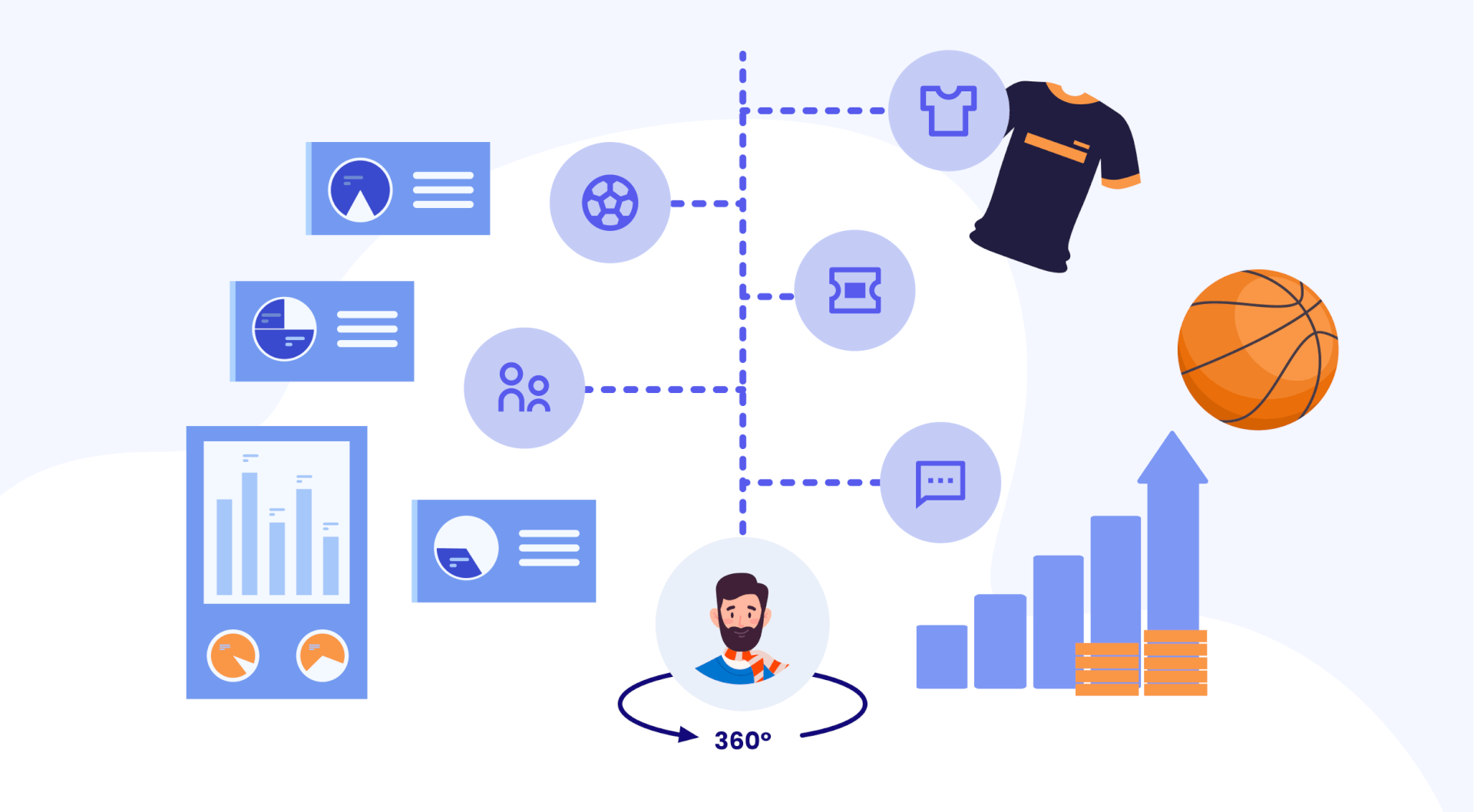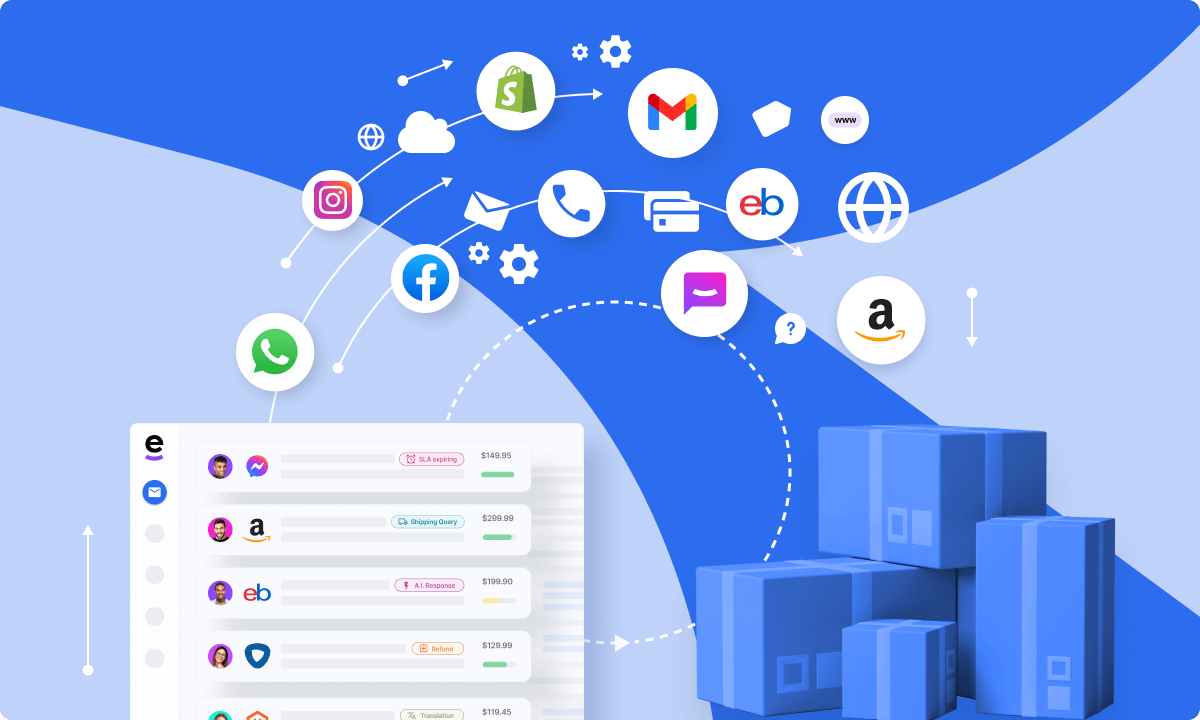Measuring the ROI of AI Marketing: Quantifying the Value of Your AI Investments
In the ever-evolving landscape of digital marketing, Artificial Intelligence (AI) has emerged as a transformative force. From ad targeting and content creation to customer analysis and campaign optimization, AI promises to streamline processes, unlock new possibilities, and ultimately, boost your marketing ROI. But amidst the hype and excitement, a crucial question remains: how do you measure the actual value of your AI investments?
Beyond the Buzzwords: Defining AI Marketing ROI
Before diving into metrics, let’s clarify what we mean by AI Marketing ROI. It’s more than just calculating the financial returns on your AI expenditure. It’s about quantifying the overall impact of AI on your marketing performance, considering both tangible (financial) and intangible benefits. These intangible benefits may include:
Increased efficiency and productivity: AI automates repetitive tasks, freeing up your team to focus on strategic initiatives.
Improved customer engagement and personalization: AI tailors experiences to individual preferences, leading to higher satisfaction and loyalty.
Enhanced decision-making: AI-powered insights guide data-driven marketing strategies, optimizing campaigns for better results.
Choosing the Right Metrics: A Multi-Faceted Approach
Measuring AI Marketing ROI requires a multi-faceted approach that goes beyond a single metric. Here are some key areas to consider:

- Financial Metrics:
Increased revenue: Track the direct impact of AI-driven campaigns on sales, conversions, and average order value.
Reduced costs: Quantify savings achieved through AI-powered automation, like ad management or content creation.
Improved return on ad spend (ROAS): Measure how efficiently AI optimizes campaigns to convert clicks into paying customers.
- Customer Engagement Metrics:
Click-through rates (CTRs): Track how AI personalizes content and ads for improved user engagement.
Website bounce rates: Monitor how AI-powered website chatbots or recommendations reduce visitor drop-off.
Social media engagement: Analyze how AI optimizes content and interactions for increased brand awareness and loyalty.
- Brand and Reputation Metrics:
Net Promoter Score (NPS): Track customer satisfaction and brand perception impacted by AI-driven experiences.
Brand mentions and sentiment analysis: Monitor how AI affects online conversations and brand perception.
Website traffic and brand searches: Analyze how AI-powered SEO and content marketing strategies impact overall online visibility.
- Operational Efficiency Metrics:
Time saved on manual tasks: Quantify the time AI frees up for your marketing team to focus on strategic initiatives.
Improved campaign turnaround times: Measure how AI streamlines campaign deployment and optimization.
Reduced errors and human bias: Track how AI ensures accuracy and consistency in data-driven decision-making.
Remember: Isolating the sole impact of AI can be challenging, as marketing efforts often involve multiple factors. Use control groups, compare pre- and post-AI implementation data, and leverage attribution models to gain a clearer picture of AI’s contribution.

Going Beyond the Numbers: The Human Factor
While metrics are essential, it’s crucial to acknowledge the “human factor” in AI ROI. Consider:
Team buy-in and adoption: Ensure your team understands and embraces AI to maximize its potential.
Data quality and bias: Garbage in, garbage out. Clean and unbiased data is crucial for accurate AI results.
Long-term perspective: AI ROI often unfolds over time, so track metrics consistently and don’t expect immediate overnight success.
Measuring the Future: A Continuous Journey
Measuring AI Marketing ROI is an ongoing process, not a one-time event. Continuously refine your approach, experiment with different metrics, and adapt your strategies as AI technology evolves. By embracing a data-driven and holistic approach, you can unlock the true potential of AI and quantify its value in building a successful and sustainable marketing future.
Social Media Marketing with AI: Optimizing Your Strategy for Maximum Reach and Engagement
The bustling world of social media can feel overwhelming for even the most seasoned marketer. From juggling multiple platforms to crafting engaging content, staying ahead of the curve requires constant effort and adaptation. Thankfully, Artificial Intelligence (AI) is no longer a futuristic dream, but a powerful tool readily available to elevate your social media marketing strategy. Let’s explore how AI can help you reach new heights on your social media journey.
Demystifying the AI Advantage: Why it Matters
Think of AI as your digital marketing wingman, working tirelessly to analyze, personalize, and automate tasks, freeing you to focus on the bigger picture. Here’s why incorporating AI into your strategy is a game-changer:
Unveiling Audience Insights: AI dives deep into data, uncovering hidden patterns and trends in your audience’s behavior, preferences, and demographics. This data-driven intelligence helps you tailor your content to resonate with the right people at the right time.
Content Creation Powerhouse: From generating catchy headlines and crafting personalized ad copy to curating visually appealing posts, AI tools assist in content creation, saving you precious time and resources.
Engagement Booster: AI algorithms identify which content sparks the most engagement, suggesting relevant hashtags, scheduling posts for optimal reach, and even responding to comments in a timely and personalized manner.
Predictive Analytics Edge: By analyzing past performance and industry trends, AI can predict which content formats and platforms will perform best, allowing you to optimize your strategy based on insights, not guesswork.
Efficiency Champion: Repetitive tasks like scheduling posts, monitoring mentions, and reporting on campaign performance become a breeze with AI automation, freeing up your time for more strategic efforts.
![]()
Diving Deeper: From Strategy to Execution
Now that you understand the benefits of AI, let’s dive into practical ways to integrate it into your social media workflow:
Know Your Audience: Begin by utilizing AI-powered audience analysis tools to understand your target demographics, interests, and online behavior. This forms the foundation for your personalized content strategy.
Content that Converts: Explore AI-powered content creation platforms that can generate ideas, headlines, even entire draft posts based on your chosen theme and target audience.
Engagement Maestro: Leverage AI-powered chatbots or social listening tools to respond to comments and messages in a timely and personalized manner, boosting engagement and customer satisfaction.
Data-Driven Decisions: Utilize AI analytics dashboards to track campaign performance, measure engagement metrics, and identify areas for improvement. Gaining these insights allows you to optimize your strategy in real-time.
Stay Ahead of the Curve: Keep an eye on emerging AI trends like image and video recognition, sentiment analysis, and influencer marketing tools to stay ahead of the competition and explore new engagement opportunities.

Navigating the AI Landscape: Tools and Resources
The world of AI-powered social media marketing tools is vast and ever-evolving. Here are some popular options to consider:
- Content Creation: Jarvis, Copy.ai, Rytr
- Audience Insights: Sprout Social, Hootsuite, Buzzsumo
- Engagement Management: ManyChat, Drift, HubSpot
- Analytics and Reporting: Brandwatch, Sprout Social, Zoho Social
- Influencer Marketing: Buzzsumo, HypeAuditor, AspireIQ
Remember, the key is to find tools that complement your specific needs and social media goals.
The Human Touch: AI Collaboration, not Replacement
It’s important to remember that AI is not a replacement for human creativity and strategic thinking. While it automates tasks and delivers valuable insights, your unique understanding of your brand, target audience, and campaign goals remains crucial. Think of AI as your powerful collaborator, empowering you to make informed decisions, optimize your strategy, and achieve unparalleled reach and engagement on social media.
By embracing AI in your social media marketing strategy, you unlock a world of possibilities, from deeper audience understanding to personalized content and data-driven optimization. So, step into the future of social media marketing, empowered by AI, and watch your brand’s engagement soar to new heights.
Beyond the Hustle: Sustainable Online Income Strategies for Long-Term Success
The internet has opened a pandora’s box of opportunities for generating income. From freelancing platforms to e-commerce stores, the allure of building an online empire is undeniable. But for many, the initial excitement fades as they get caught in the hustle trap: working long hours, chasing fleeting trends, and ultimately burning out.
This article aims to help you navigate beyond the “get rich quick” schemes and towards sustainable online income strategies that build a solid foundation for long-term success.
Shifting the Mindset:
First, let’s address the elephant in the room. Forget the “quick” part. Building a reliable online income takes time, effort, and a strategic mindset. Here are some key shifts to consider:
- Focus on Value, not Volume: Instead of churning out low-quality content or products, curate offerings that genuinely solve problems or provide an enriching experience for your audience.
- Build Relationships, not Transactions: View your audience as a community, not just sales targets. Fostering trust and connection leads to repeat customers and organic growth.
- Play the Long Game: Sustainable success is about laying a solid foundation, not reaching the top overnight. Enjoy the journey, celebrate small wins, and adapt to changing trends.

Diversify Your Income Streams:
Putting all your eggs in one basket is risky. Explore various options and create a blend that aligns with your skills, interests, and market needs. Here are some popular categories:
- Content Creation: Blogging, freelancing for writing platforms, creating online courses, or starting a YouTube channel.
- E-commerce: Selling physical or digital products through your own online store or marketplaces like Etsy or Amazon.
- Affiliate Marketing: Promoting other people’s products and earning commissions on sales.
- Freelancing: Offering your skills (writing, design, coding, etc.) through platforms like Upwork or Fiverr.
- Consulting/Coaching: Sharing your expertise and guidance on a specific topic.
- Social Media Management: Helping businesses manage their social media presence.
Choose Strategies You Enjoy:
Long-term success requires staying motivated. Choose online income paths that resonate with your passions and allow you to leverage your existing skills and talents. The more you enjoy the process, the less it feels like work and the more likely you are to persevere through challenges.

Building a Sustainable Foundation:
Now, let’s delve into specific strategies for building a lasting online income:
- Develop Your Niche: Instead of being a jack-of-all-trades, choose a specific niche where you can establish your expertise and attract a targeted audience.
- Invest in Education & Skills: Whether it’s online courses, workshops, or professional development resources, continuously upgrading your knowledge and skills sets you apart.
- Build Your Brand: Create a consistent brand identity across all your online channels, including a website, social media presence, and professional communication.
- Focus on SEO & Content Marketing: Create high-quality, engaging content optimized for search engines to attract organic traffic to your website or platforms.
- Nurture Your Audience: Build an email list, engage with comments, and actively participate in relevant online communities to connect with your audience and build loyalty.
- Analyze & Adapt: Regularly track your results, identify areas for improvement, and adapt your strategies based on data and feedback.
Remember:
- Sustainability takes time: Don’t get discouraged by slow progress. Celebrate small wins and focus on consistent effort and improvement.
- There’s no “one-size-fits-all” approach: Experiment with different strategies and find what works best for you and your niche.
- Stay ethical and authentic: Build trust with your audience by offering genuine value and avoiding misleading tactics.
- Enjoy the journey: Remember, the process of building an online income should be fulfilling, not just exhausting. Focus on learning, growing, and connecting with your community.
By shifting your mindset, diversifying your income streams, and investing in building a solid foundation, you can move beyond the hustle and create a sustainable online income that supports your long-term goals and allows you to truly thrive in the digital landscape.
Predictive Analytics in Sales: Using AI to Forecast Customer Behavior and Close More Deals
In today’s competitive business landscape, understanding your customers is key to survival. But with the explosion of data, deciphering customer behavior and predicting future actions can feel like gazing into a crystal ball. Thankfully, the future is brighter than you think, illuminated by the power of predictive analytics in sales.
Harnessing the power of artificial intelligence (AI) and machine learning (ML), predictive analytics sifts through vast amounts of customer data, uncovering hidden patterns and trends. This translates into real-world benefits for sales teams, enabling them to:
Forecast customer behavior: Predict the likelihood of purchase, churn, and upsell opportunities, allowing you to prioritize leads and allocate resources effectively.
Identify high-value customers: Spot the customers who are most likely to spend big, enabling you to focus your efforts on driving maximum ROI.

Personalize the sales experience: Tailor your outreach and messaging based on individual customer needs and preferences, increasing engagement and conversion rates.
Optimize pricing strategies: Set dynamic prices that maximize revenue based on customer segments and predicted purchase behavior.
Reduce churn: Proactively identify customers at risk of leaving and implement targeted retention strategies.
But how does it work? The magic behind predictive analytics lies in its ability to analyze historical data, including:
- Customer demographics and purchase history: Age, location, buying habits, etc.
- Website interaction: Clickstream data, page views, abandoned carts, etc.
- Social media behavior: Likes, shares, comments, etc.
- Email engagement: Open rates, click-through rates, etc.
- External factors: Economic trends, competitor activity, industry news, etc.
By feeding this data into sophisticated algorithms, predictive analytics models can identify correlations and predict future customer behavior with surprising accuracy. Imagine knowing which leads are most likely to convert, what products a customer is likely to purchase next, or when they might be at risk of churning. This knowledge empowers sales teams to:

Target the right prospects: Focus efforts on qualified leads with a high chance of closing, maximizing lead conversion rates.
Nurture leads effectively: Personalize communication and tailor offers based on predicted needs and buying stages.
Upsell and cross-sell strategically: Recommend relevant products based on past purchases and predicted preferences.
Proactively address churn: Identify at-risk customers and intervene with targeted retention campaigns before they leave.
Implementing predictive analytics doesn’t require a team of data scientists. Numerous user-friendly software solutions are available, designed specifically for sales teams. These tools provide intuitive dashboards and actionable insights, empowering even non-technical users to leverage the power of AI.
However, it’s important to remember that predictive analytics is just a tool, not a magic bullet. Its effectiveness relies on several factors:
Data quality: Ensure your data is accurate, complete, and relevant for the predictions you want to make.
Model selection: Choose the right predictive model based on your specific goals and data characteristics.
Model training and monitoring: Regularly update your models with fresh data to ensure they remain accurate and adapt to changing trends.
By understanding the potential and limitations of predictive analytics, sales teams can unlock a powerful weapon in their arsenal. It’s about harnessing the power of data to gain deeper customer insights, predict future behavior, and ultimately close more deals.
So, ditch the crystal ball and embrace the data-driven future of sales with predictive analytics. Remember, the more you know about your customers, the better equipped you are to win their hearts (and wallets)!
Chatbots for Business: Enhancing Customer Service with AI-Powered Conversations
In today’s hyper-connected world, customer service plays a critical role in brand loyalty and success. Businesses strive to offer personalized, efficient, and around-the-clock support, but traditional methods can be resource-intensive and limited by operational hours. Enter the chatbot, an AI-powered virtual assistant revolutionizing the way businesses interact with their customers.
What are Chatbots?
Chatbots are software programs that simulate human conversation through text or voice interactions. They leverage Natural Language Processing (NLP) to understand user queries, provide automated responses, and even engage in simple dialogues. Imagine a friendly, helpful assistant available 24/7 to answer customer questions, resolve basic issues, and streamline interactions.
Benefits of Chatbots for Customer Service:
24/7 Availability: Chatbots never sleep, offering on-demand assistance regardless of time zone or holidays. This improves customer satisfaction and reduces wait times.
Scalability and Efficiency: One chatbot can handle multiple conversations simultaneously, freeing up human agents for complex inquiries. This reduces operational costs and increases efficiency.
Personalized Interactions: Chatbots can be programmed to gather information and personalize responses based on user profiles and past interactions, creating a more engaging experience.
Proactive Support: Chatbots can initiate conversations, offering help or answering FAQs before customers even ask. This reduces support tickets and proactively addresses potential issues.
Data Collection and Insights: Chatbot interactions generate valuable data on customer behavior, preferences, and common questions. This data can be used to improve service, predict needs, and personalize future interactions.

Types of Chatbots for Customer Service:
Rule-based: These bots follow pre-defined rules and scripts to answer specific questions and address simple issues. They are efficient but lack flexibility for complex inquiries.
Machine Learning: These bots learn from data and experience, improving their ability to understand and respond to user queries over time. They offer more natural conversations and can handle more complex scenarios.
Hybrid: These bots combine rule-based and machine learning approaches, offering a balance between efficiency and flexibility.
Integrating Chatbots into Your Business:
Define your goals: What are you hoping to achieve with a chatbot? Answering FAQs, resolving basic issues, or collecting feedback are common goals.
Choose the right technology: Consider your budget, technical expertise, and required functionalities when selecting a chatbot platform.
Design the user experience: Ensure your chatbot is user-friendly with clear instructions and natural language processing.
Train your bot: Provide your chatbot with relevant data and examples to enable it to understand and respond to user queries effectively.
Measure and refine: Monitor your chatbot’s performance and collect user feedback to continuously improve its accuracy and effectiveness.

The Future of Chatbot-powered Customer Service:
Chatbots are constantly evolving, incorporating advanced AI capabilities like sentiment analysis and personalized recommendations. This will lead to more seamless, human-like interactions and deeper customer understanding. The future of customer service is likely a hybrid model, where chatbots handle routine tasks and human agents address complex situations and build deeper relationships with customers.
Beyond Customer Service:
While customer service is a primary application, chatbots are finding uses in various business functions, including:
- Marketing: Qualifying leads, collecting feedback, and providing product recommendations.
- Sales: Answering pre-purchase questions and guiding customers through the sales funnel.
- Human Resources: Onboarding new employees, answering FAQs, and scheduling meetings.
Conclusion:
Chatbots are not meant to replace human interaction, but rather to augment and enhance it. By embracing AI-powered conversations, businesses can offer superior customer service, gain valuable insights, and operate more efficiently. As chatbot technology continues to evolve, its impact on the business landscape will only grow, shaping the future of customer interactions and experiences.
Subscription Service for AI-Generated Marketing Content: Offering a subscription service for businesses to access AI-generated blog posts, social media content, and marketing copy.
Creating killer marketing content consistently can feel like a marathon, not a sprint. Time, resources, and inspiration often run dry, leaving you scrambling to fill calendars and captivate audiences. This is where an AI-powered subscription service for marketing content enters the scene, offering a revolutionary approach to content creation.
Imagine:
- Never facing writer’s block again: Generate blog posts, social media captions, and even website copy in minutes with the help of powerful AI algorithms.
- Saving precious time and money: Instead of hiring freelance writers or agencies, access a vast library of high-quality content at a fraction of the cost.
- Targeting your audience with laser precision: Tailor content to specific demographics, interests, and buying stages, ensuring maximum engagement and conversions.
- Scaling your content strategy effortlessly: Whether you’re a small business owner or a marketing manager for a large corporation, easily adapt your content output to meet your needs.
This subscription service unlocks a treasure trove of AI-generated marketing content, empowering you to:
Craft Compelling Blog Posts:
- Choose from various blog post templates catering to different industries and content goals.
- Provide basic information about your target audience and desired keyword focus.
- Let AI do its magic! Receive well-structured, informative, and SEO-optimized blog posts ready to publish.
Ignite Social Media Engagement:
- Generate catchy captions and headlines for all major social media platforms.
- Input specific product features, promotions, or brand messages you want to convey.
- Receive unique and engaging social media content that sparks conversation and attracts followers.

Persuasive Marketing Copy:
- Create high-converting website copy, product descriptions, or email marketing campaigns.
- Provide relevant details about your offerings and target audience.
- Receive persuasive and action-oriented copy that drives sales and conversions.
Beyond the Basics:
The service doesn’t just offer pre-built templates. Customize your content further by:
- Choosing different writing styles and tones: From casual and conversational to formal and authoritative, match your brand voice.
- Setting specific content length and complexity: Generate short snippets or in-depth articles based on your needs.
- Integrating with existing tools and workflows: Connect with popular marketing platforms for seamless content distribution.
Addressing Concerns:
While AI-generated content offers undeniable benefits, concerns often arise about originality and brand authenticity. This service addresses these concerns head-on:
- Human oversight and editing: All AI-generated content can be reviewed and edited by human professionals for quality assurance and brand alignment.
- Fact-checking and plagiarism detection: Rigorous checks ensure factual accuracy and complete originality of all content.
- Customization and brand voice integration: Maintain your unique brand identity by tailoring content to your specific tone, style, and messaging.

Subscription Options:
Choose a plan that fits your content needs and budget:
- Basic: Access a limited selection of templates for blog posts and social media content.
- Standard: Expanded template library, increased content output, and basic customization options.
- Premium: Full access to all templates, advanced customization tools, human editing options, and dedicated account management.
The Future of Marketing is Here:
This subscription service for AI-generated marketing content offers a glimpse into the future of content creation. By leveraging the power of AI, you can streamline your workflow, save resources, and consistently deliver high-quality content that resonates with your audience. Embrace the future and unlock the full potential of your marketing with AI by your side.
Hyper-Personalization with AI: Tailoring Your Marketing Messages for Increased Engagement
In today’s digital age, consumers are bombarded with marketing messages from all sides. Standing out in this crowded landscape requires more than just catchy slogans and flashy visuals. Enter hyper-personalization, a powerful marketing strategy that leverages AI to tailor messages to individual needs and preferences, leading to deeper engagement and stronger brand connections.
Beyond Segmentation: Diving into Hyper-Personalization
Traditionally, marketers segmented audiences based on demographics, interests, or purchase history. While effective, this approach treats customers as groups, not individuals. Hyper-personalization takes it a step further, leveraging AI to create unique experiences for each customer. Imagine your website adapting to a visitor’s past browsing behavior, recommending products they’re more likely to be interested in, or receiving an email celebrating your birthday with a personalized discount. This is the power of hyper-personalization in action.
AI: The Engine of Hyper-Personalization
AI plays a crucial role in analyzing vast amounts of customer data, including:
Purchase history: What products have they bought? What are their spending habits?
Website behavior: What pages do they visit? What content do they engage with?
Social media interactions: What are their interests and preferences based on online activity?
Demographic information: Age, location, and other relevant data points.
Through AI algorithms, this data is transformed into actionable insights. These insights reveal individual preferences, purchase patterns, and even future needs, allowing marketers to craft highly targeted messages that resonate with each customer on a personal level.

Benefits of Hyper-Personalization: From Engagement to ROI
The benefits of hyper-personalization extend far beyond simply sending “Dear [Name]” emails. Here’s how it can positively impact your marketing efforts:
Increased engagement: Customers are more likely to pay attention to and interact with messages that feel relevant and tailored to their needs.
Improved conversion rates: Personalized offers and recommendations are more likely to convert prospects into customers.
Stronger brand loyalty: When customers feel valued and understood, they become more loyal to your brand.
Enhanced customer lifetime value: Providing personalized experiences fosters long-term relationships with customers, leading to increased revenue over time.
Data-driven decision making: AI-powered insights allow you to optimize your marketing campaigns and allocate resources more effectively.
Examples of Hyper-Personalization in Action:
Here are some real-world examples of how brands are using AI-powered hyper-personalization:
- Netflix: Recommends shows based on your watch history and viewing preferences.
- Amazon: Suggests products based on your past purchases and browsing behavior.
- Spotify: Creates personalized playlists based on your listening habits.
- Sephora: Recommends beauty products based on your skin type and makeup preferences.
- Nike: Offers personalized discounts and product recommendations based on your fitness goals and activity data.

Getting Started with Hyper-Personalization: A Step-by-Step Guide
Ready to implement hyper-personalization in your own marketing strategy? Here are some steps to get you started:
- Define your target audience: Who are you trying to reach? Consider demographics, interests, and behaviors.
- Collect and analyze customer data: Leverage website analytics, CRM systems, and social media data.
- Invest in AI-powered marketing tools: Choose platforms that offer personalization features and data analytics capabilities.
- Start small and experiment: Begin with A/B testing different personalization tactics to see what resonates with your audience.
- Respect privacy and transparency: Be clear about how you collect and use customer data, and prioritize privacy and security.
The Future of Hyper-Personalization: A Journey, Not a Destination
Hyper-personalization is no longer a passing trend, but a crucial element of effective marketing in the digital age. As AI technology continues to evolve, we can expect even more sophisticated and nuanced personalization techniques to emerge. However, it’s important to remember that hyper-personalization should not feel intrusive or creepy. The goal is to build genuine connections with customers, not invade their privacy.
By embracing AI responsibly and ethically, hyper-personalization can transform your marketing efforts, fostering deeper engagement, building stronger brand loyalty, and ultimately driving sustainable growth in the years to come.
Can AI Be Creative? Exploring the Role of AI in Art, Music, and Writing
Creativity, that spark of originality that fuels art, music, and writing, has long been considered a uniquely human domain. But as artificial intelligence (AI) evolves, blurring the lines between human and machine capabilities, the question arises: can AI truly be creative? Join us on an exploration of AI’s burgeoning role in creative fields, examining its potential, limitations, and the fascinating collaboration emerging between artist and machine.
Stepping Outside the Lines: AI’s Artistic Expressions
AI’s impact on art is undeniable. Algorithms can now:
Generate captivating visuals: Using deep learning, AI can create stunning paintings, sculptures, and even videos, often mimicking artistic styles with impressive accuracy.
Compose novel music: AI-powered systems can produce original melodies, harmonies, and even orchestral pieces, blurring the line between human composer and algorithmic conductor.
Craft compelling narratives: Chatbots write poems, scripts, and even novels, showcasing AI’s ability to manipulate language and structure stories.
Yet, questions linger. Does AI truly “understand” these creations? Is it expressing emotions, or simply mimicking patterns it has observed?

Demystifying the Creative Process: Human vs. Machine
Human creativity stems from a complex interplay of emotions, experiences, and imagination. We draw inspiration from the world around us, imbuing our creations with personal meaning and emotional depth. AI, on the other hand, lacks this lived experience. It creates by analyzing patterns and manipulating data, producing results that are often technically impressive, but may lack the emotional resonance that defines human art.
This distinction becomes especially apparent in fields like writing, where capturing nuance and evoking emotions are crucial. While AI can craft grammatically correct text, it often struggles to grasp the subtleties of human language, the double entendres, the hidden meanings that truly spark our imagination.
Beyond Imitation: AI as a Collaborative Muse
Instead of viewing AI as a competitor, a more fruitful approach lies in collaboration. Imagine AI as a powerful tool, a digital muse that can:
Generate endless creative prompts: Overcoming writer’s block, AI can suggest unexpected story ideas, character traits, or plot twists, sparking the human artist’s imagination.
Explore vast artistic landscapes: With its ability to analyze massive datasets, AI can suggest artistic styles, color palettes, or musical influences that the human artist may never have considered, expanding their creative horizons.
Refine and iterate: AI can provide objective feedback on drafts, suggest stylistic improvements, or even rewrite sections to enhance clarity or flow, while the human artist retains creative control.
This collaborative approach leverages the strengths of both, fostering a symbiosis between human intuition and computational power.

Looking Ahead: The Evolving Canvas of AI in Art
The debate on AI’s creativity is far from settled. However, one thing is clear: AI is leaving an indelible mark on the creative landscape. While it may not possess the emotional depth of human artistry, its ability to generate, suggest, and refine opens exciting possibilities for the future. As AI continues to evolve, we can expect to see even more sophisticated collaborations, pushing the boundaries of creativity and redefining what it means to be an artist in a machine-augmented world.
AI in E-commerce: Personalized Shopping Experiences
In the fiercely competitive landscape of e-commerce, standing out requires more than just a well-designed website and a diverse product catalog. Today, savvy businesses are increasingly turning to artificial intelligence (AI) to personalize the shopping experience, optimize pricing strategies, and ultimately, drive conversions and customer loyalty. This guide dives into the exciting world of AI-powered e-commerce, exploring how you can leverage this technology to take your online store to the next level.
Why Embrace AI in E-commerce?
Traditional e-commerce often presents a generic one-size-fits-all approach, failing to cater to individual customer preferences and needs. AI changes the game by:
- Understanding your customers: Analyze purchase history, browsing behavior, and demographic data to create detailed customer profiles.
- Predicting preferences: AI algorithms can recommend products customers are likely to buy, increasing impulse purchases and average order value.
- Dynamic pricing: Adjust prices based on real-time factors like demand, competitor pricing, and customer segments, maximizing profits while remaining competitive.
- Personalized marketing: AI-powered email campaigns and targeted advertisements deliver relevant content that resonates with individual customers.
- Enhanced search: Implement natural language processing to understand customer intent and deliver accurate search results, reducing frustration and improving satisfaction.
- Improved customer service: Chatbots powered by AI can answer common questions, troubleshoot issues, and offer personalized support, 24/7.
These advantages translate into tangible benefits: increased sales, higher customer engagement, improved brand loyalty, and valuable insights into your customer base.

Key AI Applications for E-commerce:
Building your AI-powered store involves integrating various applications:
- Product Recommendations: Go beyond the basic “customers who bought this also bought” with AI. Consider advanced algorithms that factor in purchase history, browsing behavior, product attributes, and even seasonal trends to deliver highly relevant recommendations that entice customers to buy more.
- Dynamic Pricing: Implement AI-driven pricing strategies that automatically adjust prices based on market demand, competitor offerings, and customer data. This ensures you stay competitive while maximizing revenue potential.
- Personalized Search: Leverage natural language processing (NLP) to understand customer search queries and deliver accurate results, even if phrased differently from your product descriptions. This reduces frustration and leads to faster conversions.
- Chatbots: Integrate chatbots powered by AI to answer frequently asked questions, provide product information, and troubleshoot customer issues. This offers 24/7 support and reduces the burden on your customer service team.
- Marketing Automation: AI can personalize marketing campaigns by analyzing customer data and segmenting audiences. This ensures targeted messaging that resonates with individual customers, increasing engagement and click-through rates.
Building Your AI Arsenal: Tools and Platforms
Several tools and platforms cater to e-commerce businesses looking to incorporate AI:
- Shopify AI: This built-in feature offers product recommendations, abandoned cart recovery, and fraud detection.
- BigCommerce: They provide AI-powered product recommendations, personalized search, and abandoned cart emails.
- Amazon Personalize: This service offers custom recommendation engines and dynamic pricing tools.
- Einstein for Commerce: Salesforce’s solution features AI-powered search, product recommendations, and marketing automation.
- Third-party tools: Numerous companies offer specialized AI solutions for e-commerce, focusing on specific areas like chatbots, pricing optimization, or personalization.
Implementing AI Responsibly: Considerations and best Practices
While AI offers immense potential, responsible implementation is crucial:
- Data privacy: Ensure transparency and compliance with data privacy regulations when collecting and utilizing customer data.
- Explainability and fairness: Strive for explainable AI models that avoid perpetuating bias or discrimination.
- Human oversight: Don’t replace human interaction entirely; utilize AI to empower your team and enhance customer service.
- Start small and scale: Begin with a single AI application, measure its impact, and gradually expand based on results.
By prioritizing these elements, you can build an AI-powered e-commerce store that benefits customers, ethically uses data, and delivers a truly personalized shopping experience.
The Future of AI in E-commerce: A World of Possibilities
AI is rapidly evolving, and its potential in e-commerce is vast. Imagine:
- Voice-powered shopping: Customers using voice commands to search for products and complete purchases.
- Hyper-personalized experiences: Stores tailoring every aspect of the shopping journey to individual preferences.
- Predictive analytics: AI anticipating customer needs and suggesting products before they even realize they want them.
While these might seem futuristic, they are closer than we think. By embracing AI today, you position your e-commerce store for a future where personalized experiences reign supreme.
Rise of the Machines? Examining the Potential Job Disruption and Creation by AI
The rise of artificial intelligence (AI) has sparked both excitement and fear. While its potential to revolutionize industries and improve our lives is undeniable, the specter of mass job displacement looms large. This article delves into the complex relationship between AI and the future of work, examining both the disruptive and creative potential of this rapidly evolving technology.

AI: A Double-Edged Sword for Jobs
On the one hand, AI automation poses a significant threat to certain occupations. Repetitive, predictable tasks are particularly vulnerable, as machines can perform them faster and more efficiently. Jobs in manufacturing, transportation, and administrative sectors are often cited as being at high risk. Studies estimate that millions of jobs could be lost globally in the coming decades due to AI automation.
This potential disruption raises valid concerns about worker displacement, income inequality, and social unrest. Individuals whose skills become obsolete may face challenges finding new employment, particularly if they lack the access or resources to retrain. The impact on specific communities and demographics needs careful consideration to ensure an equitable transition in the evolving job market.
However, the narrative is not solely one of job losses. AI is also a powerful job creator. As new industries emerge and existing ones transform, demand for new skillsets will surge. Here are some areas where AI is likely to drive job creation:
`1. AI development and implementation: Engineers, data scientists, programmers, and other specialists will be needed to design, develop, and maintain AI systems.
- AI-powered services: Jobs in areas like data analysis, cybersecurity, and AI ethics will be crucial for managing and safeguarding AI applications.
- Human-AI collaboration: Roles that leverage the unique strengths of both humans and AI, such as AI-assisted designers, healthcare professionals, and teachers, are likely to see growth.
Furthermore, AI can indirectly create jobs by boosting economic productivity and innovation. This, in turn, can lead to increased demand for goods and services, stimulating job creation across various sectors.
Navigating the AI Revolution: Skills for the Future
The key to successfully navigating the AI-driven job market lies in continuous learning and upskilling. Here are some crucial steps individuals can take:
Develop adaptability and lifelong learning: Embrace the need to continuously learn new skills and adapt to evolving technologies.
Focus on uniquely human skills: Cultivate critical thinking, creativity, problem-solving, and emotional intelligence, areas where AI currently struggles.
Seek education and training in emerging fields: Explore opportunities to gain expertise in areas like data science, AI development, and human-computer interaction.
Embrace lifelong upskilling and reskilling: Governments, educational institutions, and businesses need to collaborate to provide accessible and affordable reskilling programs for displaced workers.

Shaping a Human-Centered Future with AI
While there are undeniable challenges, we can shape the future of AI to benefit everyone. Here are some key considerations:
Responsible AI development: Implementing ethical guidelines and ensuring transparency in AI algorithms is crucial to prevent bias and discrimination.
Investing in workforce development: Providing accessible and relevant upskilling programs is essential to prepare individuals for the changing job market.
Universal basic income (UBI): This could provide a safety net for individuals displaced by automation and ensure a smoother transition.
Social safety nets: Strengthening social safety nets like unemployment benefits and job search assistance can support individuals facing job losses.
By proactively addressing the challenges and capitalizing on the opportunities, AI can become a powerful tool for progress, enriching our lives and creating a more prosperous future for all. It is not about robots replacing humans, but rather humans and AI working together to build a better world.


